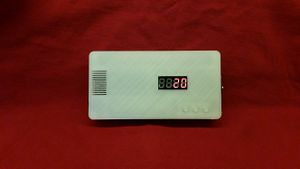Geiger counter
A Geiger counter has been on my list of projects for a while, and in Spring 2018 I made one based on the very available Russian SBM-20 Geiger-Muller tubes, one of the most common cheap tubes on Ebay.
The heart of the Geiger counter is the GM tube, which is a tube filled with gas, and two electrodes. A high voltage is applied to the tube, usually around 400 volts. When a particle of ionizing radiation passes through the tube, it will ionize a molecule of the gas, and allow a tiny bit of current to flow through the tube. If we can detect the tiny current that flows through the tube, we can count them and find out the rate of radiation exposure in the area.
Hardware
I havn't opened the system for a while, and since it has been a while since building, I don't have a full schematic ready. But briefly:
- The GM tube is a SBM-20. It can measure beta and gamma radiation. A resistor of several megaohms is placed in series to protect the tube from excessive current flow.
- An ATTiny84 microcontroller controls the HV power supply, counting, and user interface.
- The pulse detection circuit is made from a couple resistors, capacitors, and transistors, and comes from one of the common Geiger kit plans available online.
- The power supply is a boost converter made from an inductor being repeatedly shut off, which creates high voltage spikes. A diode rectifies the high voltage and stores it in a capacitor. A voltage divider allows the microcontroller to read the high voltage. Signal to the boost converter is supplied by the microcontroller, at about 8kHz. PWM on this 8khz signal controls the output voltage. The ATTiny provides a feedback control system, which is an I (integral) controller, which I found was quite stable. I also tried a P controller and PI controller, but I could not tune these as well.
